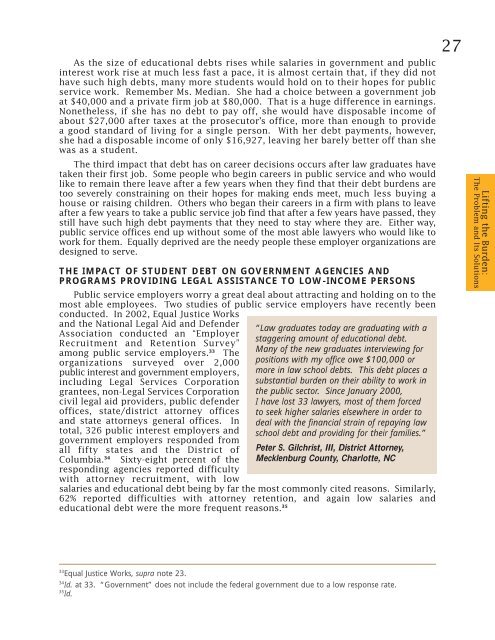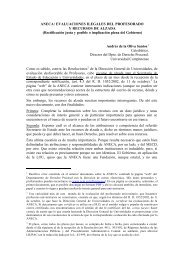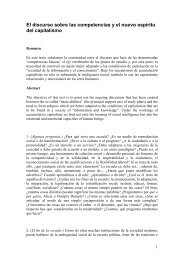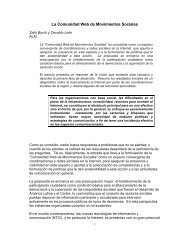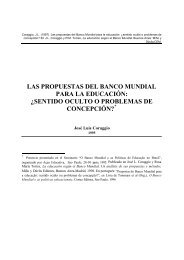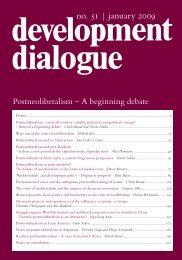As <strong>the</strong> size of educational debts rises while salaries in government and publicinterest work rise at much less f<strong>as</strong>t a pace, it is almost certain that, if <strong>the</strong>y did nothave such high debts, many more students would hold on <strong>to</strong> <strong>the</strong>ir hopes for publicservice work. Remember Ms. Median. She had a choice between a government jobat $40,000 and a private firm job at $80,000. That is a huge difference in earnings.None<strong>the</strong>less, if she h<strong>as</strong> no debt <strong>to</strong> pay off, she would have disposable income ofabout $27,000 after taxes at <strong>the</strong> prosecu<strong>to</strong>r’s office, more than enough <strong>to</strong> providea good standard of living for a single person. With her debt payments, however,she had a disposable income of only $16,927, leaving her barely better off than shew<strong>as</strong> <strong>as</strong> a student.The third impact that debt h<strong>as</strong> on career decisions occurs after law graduates havetaken <strong>the</strong>ir first job. Some people who begin careers in public service and who wouldlike <strong>to</strong> remain <strong>the</strong>re leave after a few years when <strong>the</strong>y find that <strong>the</strong>ir debt burdens are<strong>to</strong>o severely constraining on <strong>the</strong>ir hopes for making ends meet, much less buying ahouse or raising children. O<strong>the</strong>rs who began <strong>the</strong>ir careers in a firm with plans <strong>to</strong> leaveafter a few years <strong>to</strong> take a public service job find that after a few years have p<strong>as</strong>sed, <strong>the</strong>ystill have such high debt payments that <strong>the</strong>y need <strong>to</strong> stay where <strong>the</strong>y are. Ei<strong>the</strong>r way,public service offices end up without some of <strong>the</strong> most able lawyers who would like <strong>to</strong>work for <strong>the</strong>m. Equally deprived are <strong>the</strong> needy people <strong>the</strong>se employer organizations aredesigned <strong>to</strong> serve.THE IMPACT OF STUDENT DEBT ON GOVERNMENT AGENCIES ANDPROGRAMS PROVIDING LEGAL ASSISTANCE TO LOW-INCOME PERSONS<strong>Public</strong> service employers worry a great deal about attracting and holding on <strong>to</strong> <strong>the</strong>most able employees. Two studies of public service employers have recently beenconducted. In 2002, Equal Justice Worksand <strong>the</strong> National Legal Aid and DefenderAssociation conducted an “EmployerRecruitment and Retention Survey”among public service employers. 33 Theorganizations surveyed over 2,000public interest and government employers,including Legal <strong>Service</strong>s Corporationgrantees, non-Legal <strong>Service</strong>s Corporationcivil legal aid providers, public defenderoffices, state/district at<strong>to</strong>rney officesand state at<strong>to</strong>rneys general offices. In<strong>to</strong>tal, 326 public interest employers andgovernment employers responded fromall fifty states and <strong>the</strong> District of“<strong>Law</strong> graduates <strong>to</strong>day are graduating with <strong>as</strong>taggering amount of educational debt.Many of <strong>the</strong> new graduates interviewing forpositions with my office owe $100,000 ormore in law school debts. This debt places <strong>as</strong>ubstantial burden on <strong>the</strong>ir ability <strong>to</strong> work in<strong>the</strong> public sec<strong>to</strong>r. Since January 2000,I have lost 33 lawyers, most of <strong>the</strong>m forced<strong>to</strong> seek higher salaries elsewhere in order <strong>to</strong>deal with <strong>the</strong> financial strain of repaying lawschool debt and providing for <strong>the</strong>ir families.”Peter S. Gilchrist, III, District At<strong>to</strong>rney,Columbia. 34 Sixty-eight percent of <strong>the</strong> Mecklenburg County, Charlotte, NCresponding agencies reported difficultywith at<strong>to</strong>rney recruitment, with lowsalaries and educational debt being by far <strong>the</strong> most commonly cited re<strong>as</strong>ons. Similarly,62% reported difficulties with at<strong>to</strong>rney retention, and again low salaries andeducational debt were <strong>the</strong> more frequent re<strong>as</strong>ons. 3527<strong>Lifting</strong> <strong>the</strong> <strong>Burden</strong>:The Problem and Its Solutions33Equal Justice Works, supra note 23.34Id. at 33. “Government” does not include <strong>the</strong> federal government due <strong>to</strong> a low response rate.35Id.
<strong>Lifting</strong> <strong>the</strong> <strong>Burden</strong>:The Problem and Its Solutions28In 2002, a Committee of <strong>the</strong> New York State Bar Association completed a study bymail of New York public service employers, including government and legalservices. 36 Of <strong>the</strong> 29 responding agencies and programs, 64% reported that candidates’student loan debts impeded <strong>the</strong> ability <strong>to</strong> recruit well-qualified at<strong>to</strong>rneys. The samepercentage reported that debts impeded <strong>the</strong>ir ability <strong>to</strong> retain at<strong>to</strong>rneys earlier hired.Those that did not report such difficulties tended <strong>to</strong> be <strong>the</strong> federal and stategovernment agencies that paid higher salaries.Some public service employers report that <strong>the</strong>y are unable <strong>to</strong> find any applicantswilling <strong>to</strong> work for <strong>the</strong>m at <strong>the</strong> salaries <strong>the</strong>y are able <strong>to</strong> pay. According <strong>to</strong> Michael P.Judge, <strong>the</strong> <strong>Public</strong> Defender for Los Angeles County, “It is common for new lawyers <strong>to</strong>be encumbered by $80,000 <strong>to</strong> $100,000, and even more, in student loans uponp<strong>as</strong>sing <strong>the</strong> Bar. The confluence of enormous student debt load and exceptionaldisparity in private practice salaries h<strong>as</strong> created a dramatic negative impact on myoffice’s recruiting and retention efforts. In <strong>the</strong>se p<strong>as</strong>t few years, I have seen far fewercandidates applying for positions with <strong>the</strong> <strong>Public</strong> Defender’s Office than previously.Due <strong>to</strong> high student debt, <strong>the</strong>re have been more than a dozen vacancies during <strong>the</strong>p<strong>as</strong>t few years, which have caused <strong>the</strong> <strong>Public</strong> Defender <strong>to</strong> be unable <strong>to</strong> handle morethan 10,000 c<strong>as</strong>es.”Legal services offices, especially those in rural are<strong>as</strong>, also report difficulty inrecruiting and retaining lawyers. Consider <strong>the</strong> experience of Nebr<strong>as</strong>ka Legal <strong>Service</strong>s:“Due <strong>to</strong> <strong>the</strong> skyrocketing student debt of recent law graduates, Nebr<strong>as</strong>ka Legal<strong>Service</strong>s h<strong>as</strong> faced serious challenges in recruiting and retaining staff at<strong>to</strong>rneys,especially in rural parts of Nebr<strong>as</strong>ka,” according <strong>to</strong> Doug German, ExecutiveDirec<strong>to</strong>r of Nebr<strong>as</strong>ka Legal <strong>Service</strong>s. German continues, “During <strong>the</strong> same timeperiod, Nebr<strong>as</strong>ka Legal <strong>Service</strong>s h<strong>as</strong> had at<strong>to</strong>rney positions unfilled in our NorthPlatte and Scottsbluff offices for over two years. We have also experienced anincre<strong>as</strong>e in at<strong>to</strong>rney turnover, with a turnover rate of 60% over a two-year period.During <strong>the</strong> p<strong>as</strong>t two years, newly hired at<strong>to</strong>rneys stayed for an average of 17months. It takes at le<strong>as</strong>t two years for an at<strong>to</strong>rney <strong>to</strong> be effective. Nebr<strong>as</strong>kaLegal <strong>Service</strong>s invests considerable time and resources in<strong>to</strong> training andrecruiting at<strong>to</strong>rneys. Our clients, and <strong>the</strong> communities in which <strong>the</strong>y live, sufferwhen we don’t have <strong>the</strong> staff <strong>to</strong> meet <strong>the</strong>ir legal needs.”The more common claim of government agencies is not that <strong>the</strong>y are unable <strong>to</strong>find new at<strong>to</strong>rneys at all. The buyer’s market for legal services is such that <strong>the</strong>re arealmost always recent law graduates willing <strong>to</strong> work. The consequence of high debtsis ra<strong>the</strong>r that public service employers have a much smaller pool of applicants <strong>to</strong>draw upon than <strong>the</strong>y o<strong>the</strong>rwise would and that many of <strong>the</strong> most able potentialapplicants and <strong>the</strong> ones who are most committed <strong>to</strong> <strong>the</strong> mission of public service –<strong>the</strong> applicants with o<strong>the</strong>r employment opportunities – take private firm jobs instead.The additional consequence is that some of <strong>the</strong> most able at<strong>to</strong>rneys who are alreadyworking for such employers choose <strong>to</strong> leave just at <strong>the</strong> point when <strong>the</strong>y are contributing<strong>the</strong> most.APPROACHES TO ALLEVIATING THE EDUCATIONAL DEBT PROBLEMThe Commission received testimony from <strong>the</strong> current generation of law students andrecent law graduates, which confirmed what a pivotal fac<strong>to</strong>r cumulative educationaldebt h<strong>as</strong> become. The Commission repeatedly heard about <strong>the</strong> dev<strong>as</strong>tating impact ofhigh student debt on public service employers’ abilities <strong>to</strong> recruit and retain lawyers.<strong>Law</strong> students shared s<strong>to</strong>ries of abandoning <strong>the</strong>ir dreams of using <strong>the</strong>ir legal skills <strong>to</strong>help <strong>the</strong>ir communities by working <strong>as</strong> a prosecu<strong>to</strong>r or legal services lawyer because of<strong>the</strong>ir inability <strong>to</strong> make ends meet, while earning lower salaries and trying <strong>to</strong> satisfy36New York State Bar Association Special Committee on <strong>Student</strong> Loan Assistance for <strong>the</strong> <strong>Public</strong> Interest,Attracting Qualified At<strong>to</strong>rneys <strong>to</strong> <strong>Public</strong> <strong>Service</strong>, June 2002.


